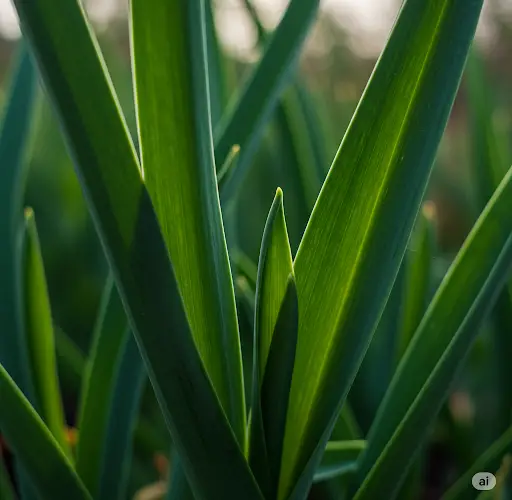Yellowing garlic leaves can be alarming for gardeners. You’ve carefully planted, watered, and nurtured your garlic, only to see the leaves start to lose their healthy green color. Does this mean the harvest is ruined? Not at all.
Yellowing garlic leaves often signal a nutrient deficiency or environmental stress, and with the right top dressing, you can bring those plants back to vibrant health. In fact, with a simple natural remedy, you can see your garlic leaves green up again and resume strong growth in a matter of days.
Why Garlic Leaves Turn Yellow
Before applying any treatment, it’s important to understand the possible reasons why garlic leaves turn yellow:
-
Nitrogen Deficiency: Garlic is a heavy feeder and needs plenty of nitrogen to maintain its lush green foliage. When the soil lacks nitrogen, the lower leaves often yellow first.
-
Water Stress: Both overwatering and underwatering can lead to yellowing leaves. Garlic needs consistent, moderate moisture—not soggy soil and not prolonged dryness.
-
Soil Compaction or Poor Drainage: If roots can’t breathe due to compacted soil or poor drainage, nutrient uptake suffers, which can cause yellowing.
-
Cold Stress: In early spring, sudden cold snaps may temporarily affect leaf color.
-
Pests or Disease: Though less common, fungal diseases or soil pests can also cause yellowing. Check the base of the plant and the soil around it for signs of damage or rot.
If the plant looks otherwise healthy and the yellowing is not due to pests or disease, a nutrient boost is likely all it needs.
The Top Dressing That Revives Garlic
A proven and natural remedy for yellowing garlic is a homemade top dressing using a nitrogen-rich solution. One of the best and easiest options is ammonia diluted in water, which quickly replenishes nitrogen levels in the soil and is readily absorbed by garlic plants.
What You’ll Need:
-
Household ammonia (unscented, clear)
-
Watering can or garden sprayer
-
Clean water
How to Prepare and Apply:
-
Mix the solution: Combine 1 tablespoon of ammonia with 1 liter (about 4 cups) of water. Stir thoroughly to dilute.
-
Apply to the root zone: Water the garlic at the base of the plant, avoiding contact with the leaves. This helps the nitrogen go directly to the roots, where it’s needed most.
-
Repeat after 7–10 days if necessary, especially if the yellowing was advanced.
Important Note: Only use household ammonia that is unscented and free of additives. Do not exceed the recommended concentration, as too much can damage the roots or alter the soil balance.
Why Ammonia Works
Ammonia contains nitrogen in a form that plants can absorb rapidly. When diluted, it acts as a fast-acting fertilizer, especially for leafy vegetables and plants like garlic that rely on strong foliage growth to fuel bulb development. Unlike slow-release fertilizers that take weeks to show results, ammonia-based feeding works almost immediately.
Within a few days of application, you may notice garlic leaves perking up, regaining their color, and showing renewed vigor.
Alternative Organic Options
If you prefer to avoid ammonia, here are some organic top dressings you can use:
-
Comfrey tea: Rich in nitrogen and potassium.
-
Nettle tea: A natural nitrogen booster made from fermented nettle leaves.
-
Diluted urine: When properly diluted (1 part urine to 10 parts water), human urine is a surprisingly effective nitrogen source.
-
Fish emulsion: Available at garden centers, fish emulsion is an excellent organic liquid fertilizer.
These options work more slowly than ammonia, but they are completely natural and add organic matter to the soil.
Preventing Yellow Leaves in the Future
To keep garlic healthy throughout the growing season, consider these proactive tips:
-
Feed regularly: Garlic benefits from nitrogen-rich top dressings every 2–3 weeks during the early stages of growth, especially in spring.
-
Ensure proper watering: Keep the soil consistently moist but never soggy. Use mulch to help retain moisture and regulate soil temperature.
-
Use loose, well-drained soil: Avoid compaction and ensure good air circulation around the roots.
-
Rotate crops: Don’t plant garlic in the same spot every year. Rotating crops helps prevent nutrient depletion and soil-borne diseases.
In Conclusion
Yellow garlic leaves don’t mean failure—they’re a sign your plants need a little help. With a quick top dressing, particularly one rich in nitrogen like diluted ammonia, your garlic can recover quickly and continue growing strong. Whether you prefer a fast-acting chemical boost or a gentler organic option, the key is acting early and giving your garlic what it needs to thrive.
Your harvest still has great potential—give your garlic a boost and enjoy a garden full of healthy green leaves and robust bulbs.



